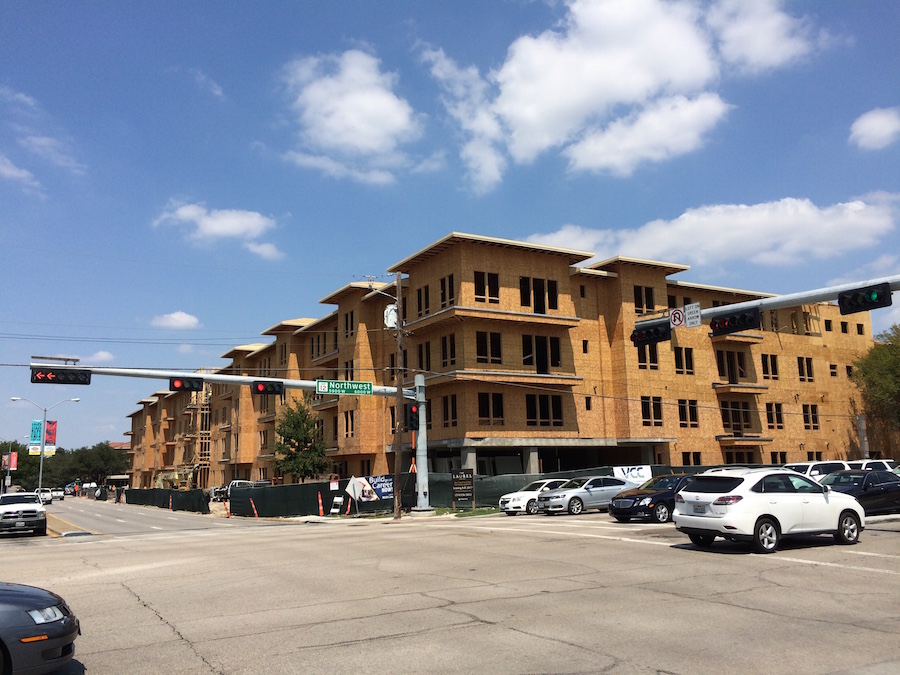Curbed takes up a topic we’ve batted around these parts before: why are new apartments in American cities so ugly? Calling it the bland, boxy apartment boom, the website wonders why so many U.S. cities are being reshaped by the same kind of mishmash-y housing that has come to define the many Dallas inner city neighborhoods that have been the beneficiaries of new investment and development over the past decade or so. Architects and urbanists have struggled to put a name on it, coming up with “Simcityism,” “SketchUp contemporary,” “Minecraftsman,” or “Revittecture.”
In their attempts to find out why this style of building has come to define new construction in American cities, Curbed encountered many of the same fundamental forces shaping design that I wrote about in this article last year. These days, aesthetics, architectural ideas, and regional sensitivity take a back seat to the more practical considerations of the development market, such as building code, construction costs, and a trend in the industry to cut expenses by bypassing architects all together. Builders defend the practice by pointing to the practical necessities of turning a profit while providing much needed new housing.
“Critics don’t understand what we’re working with, the parameters and the financial constraints,” Scott Black, senior vice president of Bristol Development, a Nashville-based firm that develops apartments across the Southeast, tells Curbed. “It’s like any other business: If you’re selling autos or selling widgets, there are certain costs, and a certain profit you need to make to do business in the future.”
But what some critics point out is that the shape of the new American city is not merely a reflection of cost. Denver-based writer Michael Paglia argues that computers, formulaic design, and predictable demand allow builders to simply throw architects and architectural considerations out the window and get their designs in a new, cheaper way:
Computer-aided design has led to a degradation of the role of architect, Paglia argued, replacing a noble craft with a series of equations that wring every last bit of value out of a site, aesthetics be damned. Formulaic floorplans are cost effective, while good design is considered an unaffordable luxury, concentrated, like so much else, among the 1 percent.
In a sense, then, what we are seeing being built in Dallas and across America is the perfect architectural expression of our age: hyper-commodification, computer-driven formality, an over-attention to surface considerations, generic, inconspicuous façades papered-over with the promise of pseudo-luxury amenities, and a dislocation for regional or cultural distinction or authenticity.
Architecture always expresses some aspect of the cultural values of an age. Victorian homes, for example, were shaped by the pomp, swagger, and buttoned-up, Romantic-Gothic playfulness of the barons of the late 19th century. Perhaps “Minecraft-ism” — or whatever you want to call it — is simply a manifestation of the increasing financialization of every aspect of contemporary life, and a reflection of way the physical world is increasingly shaped by our relationship with the digital world.
Or, perhaps more appropriately, Minecraft-ism will be mostly remembered by how disposable it is. A combination of inexpensive materials and a shortened economic life cycle mean the stud-and-drywall apartments that are sprouting up won’t last as long as the heavy stone and oak creations of the Victorians.
“I don’t think these buildings will be around in 40 years. They’ll collapse and be maintenance problems,” says Paglia. “We’ll remember the small sliver of good architecture being built today.”
Or maybe we’ll just come to love them. After all, if you look around some of the beloved older neighborhoods in Dallas, as much as you are likely to find excellent examples of craftsman and prairie home construction, you are likely to find the kinds of bungalows that early homeowners ordered straight out of the Sears-Roebucks catalog and slapped together themselves.
In other words, as Curbed points out, history tends to judge architecture “on a curve.”






